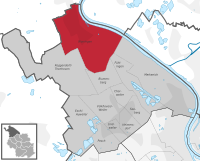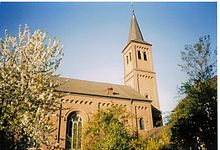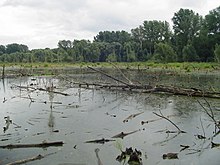Worringen
|
Worringen district 612 of Cologne |
|
|---|---|
| Coordinates | 51 ° 3 '56 " N , 6 ° 51' 54" E |
| surface | 11.72 km² |
| Residents | 10,333 (Dec. 31, 2017) |
| Population density | 882 inhabitants / km² |
| Incorporation | Apr 1, 1922 |
| Post Code | 50769 |
| prefix | 0221 |
| Borough | Chorweiler (6) |
| Transport links | |
| Highway |
|
| Federal road |
|
| Railway lines | S 6 S 11 |
| Bus routes | 120 123 885 980 |
| Source: 2017 residents . (PDF) Cologne district information | |
Worringen is the northernmost district of Cologne in the borough of Chorweiler .
location
Worringen is on the left Lower Rhine .
The neighboring districts are Roggendorf / Thenhoven in the west, Blumenberg , Fühlingen and Merkenich in the south . To the north of Worringen is the city of Dormagen in the Rhine district of Neuss , to the east - across the Rhine - is Monheim am Rhein .
history
Antiquity
The area of the district has been populated since around 500 BC. The first settlers were the Eburones who lived around 20 BC. Were replaced by the Ubiern . The Romans followed around AD 50 and the Franks around 355 . The existence of Roman manors has been archaeologically proven, but a Buruncum fort remains controversial. The spelling for Worringen has changed frequently over the centuries, and there are also: Worunc, Worunch, Woronc, Woring, Woeringen and Wuring.
middle Ages
Worringen was first mentioned in a document in 922. In 1151, the Count of Jülich sold the Vogtei Worringen to the Cologne Cathedral Provost. Count Wilhelm von Holland was elected German king on October 3, 1247 in the open field in front of Worringen. In the 12th and 13th centuries, the old Pankratius Church, which still exists today, but is no longer used as a church, was built.
For many centuries, Worringen was the largest town between Cologne and Neuss. The Worring residents found their livelihood not only in agriculture and Rhine fishing, but also through the passing trade, which ensured the existence of several inns.
The Archbishop of Cologne as territorial lord secured the strategically important place with a castle . In 1288, the Battle of Worringen took place south of the town , in which an alliance of various princes of the region together with the citizens of Cologne defeated the Archbishop of Cologne, Siegfried von Westerburg , their city lord, and his allies. As a result, u. a. Düsseldorf the city rights. The victory also made Cologne a de facto Free Imperial City , although formally it should take until 1475 for this status to be granted. The Worringer Burg had to be destroyed at the behest of the victors. It was no longer built.
In the Middle Ages, Worringen looked like a small town on the Lower Rhine with three city gates and a wall. However, in contrast to the fortress of Zons located a few kilometers down the Rhine , the place was not granted city rights.
Modern times
In 1794 French revolutionary troops occupied Worringen and assigned the place to the 3rd canton of the former territory of the Archbishopric of Cologne. In 1796 the Mairie Worringen was formed. It belonged to the canton of Zons since 1798 and half a year later to the canton of Dormagen in the Arrondissement de Cologne in the Département de la Roer . In 1815 the foundation of the Prussian mayor Worringen that for 1816 was made the district Cologne in Cologne Region belonged. The villages of Worringen (with the courtyards of Arff Castle south of Dormagen- Hackenbroich , Brüngesrather Hof, Bergerhof, Krebelshof, Blechhof near Delhoven , Chorbusch, Furth and Piwipp near Dormagen-Rheinfeld ), Roggendorf-Thenhoven, Weiler, Fühlingen (with Feldkassel and Stallagsberg), Langel (with Rheinkassel and Kasselberg), and Merkenich with the farms of Klein-Lachem and Groß-Lachem, which lay south of Merkenich - today the Cologne-Nippes district .
Attempts by the localities of Fühlingen and Weiler to form a special community in the mayor's office in Worringen in 1869 failed.
The mayor's official seat was initially in Worringen, from 1838 to 1867 in Fühlingen and then again in Worringen, where the town hall was built in 1908 .
The incorporation of the mayor's office in Worringen to Cologne happened in 1922. A small part of the former mayor's office was assigned to Dormagen ( Piwipp ). Even today, the Worringers maintain a relatively large mental distance from Cologne. Worringen has its own, independent carnival, and the carnival procession in Worringen takes place on Shrove Monday, while in all other Cologne districts and other suburbs the local carnival procession takes place on Saturdays, Sundays or Tuesdays.
A large part of the working population works in the neighboring chemical industry.
mayor

From 1797 Franz Adam Cremerius was Maire von Worringen in office. He was also the owner of the Pilgramshof and the Bergerhof. After Worringen fell to the Kingdom of Prussia in 1815, he remained in office as mayor until 1835. In 1819 Franz Adam Cremerius tried in vain to swap land with the mayor of Dormagen. The area on the Rhine up to Haus Piwipp was to be exchanged for the villages of Hackhausen and Hackenbroich. Because of his merits, he was made a Knight of the Red Eagle Order. Franz Adam Cremerius died in 1852 at the age of 88.
From 1832 to 1835 the first alderman of Worringen's mayor, Theodor Bollig , was acting as head of administration.
Heinrich Bender followed as mayor from 1835 to 1866 . He moved the official seat from Worringen to Fühlingen. Fühlingen was centrally located in the Mayor's office in Worringen. Little is known about his tenure in office. During his tenure in 1848 there was a gathering of around 8,000 people on the Rhine meadows, at which Friedrich Engels and Ferdinand Lassalle gave a speech. Heinrich Bender died in 1883 and was buried in the Rheinkassel cemetery.
From 1866 to 1907 - i.e. 41 years - Matthias Bender was mayor of Worringen. He was the son of Heinrich Bender. Matthias Bender moved the official business from Fühlingen back to Worringen. During the Kulturkampf he also held the office of local school inspector for Worringen and Thenhoven for 13 years. He was also the dike captain. From 1902 to 1911 Matthias Bender ran an acetylene gas plant, but it had to be shut down. He campaigned in vain for the construction of a small railway from Merkenich via Langel to Worringen. So that Worringen received a town hall, he gave the community a piece of land. At the same time, a small administration was set up during his tenure with the approval of the local council. Matthias Bender got a clerk, a construction clerk and a renter. After his retirement, Bender traveled to the Orient, Africa and southern Europe. He died in 1917.
The last mayor of Worringen was Josef Seul from 1907 to 1922. During his term in office, the new town hall was opened in 1907. At the same time, the administrative staff was increased considerably. During his tenure, Josef Seul had numerous streets paved and ditches channeled. In 1912 he negotiated with Bayer AG about a settlement in the north of Worringen. Bayer AG settled there a few years later, but the plant was not named Bayer Worringen, but Bayer Dormagen. Finally Josef Seul enforced the incorporation of the mayor's office in Worringen into Cologne on April 1, 1922.
Demographic statistics
Structure of the population of Cologne-Worringen:
- Share of under 18s: 18.4% (2015)
- Proportion of over 64-year-olds: 19.2% (2015)
- Proportion of foreigners: 13.1% (2015)
- Unemployment rate: 7.6% (2014)
religion
The Roman Catholic parish church of St. Pankratius was built in 1837 and supplemented in 1848 by the tower that can be seen from afar. As early as 1866, the church was converted into a three-aisled hall church by installing vaults and two rows of columns . The older medieval building on the old market square , which had become too small, was converted into a school. The old church tower and the nave, which has now been converted into a residential building, are still there. The Evangelical Peace Church was completed in 1961. There is also a house of God of the New Apostolic Church.
Culture and leisure
Leisure facilities
The Worringer Bruch nature reserve is located southwest of Worringen. Here there is the possibility of extensive hikes. The Rhine meadows south-east of Worringen are also ideal for a hike. On the western edge of Worringen, in the Roggendorf district, the Cologne Public Golf Course, an 18-hole golf course , has been located since 1995 .
societies
Worringen has 70 clubs. Among other things, here is Cologne's third largest sports club, the SG Köln-Worringen and six carnival clubs . In contrast to all other parts of the city, the carnival parade in Worringen may take place on Rose Monday. In addition to the volunteer fire brigade, which belongs to the Cologne fire brigade, the scout tribe "Gilwell" and the KJG Worringen are based in Worringen. Further communities can be found in the DSkV skat club "Wurringer Junge" and the association "Motorradfreunde Worringen".
Culture
The Worringer Heimatarchiv (Breiter Wall 4) publishes the local history in various exhibitions with photos, documents and objects.
Economy and Infrastructure
Between Worringen and Dormagen to the north there are extensive chemical industry facilities, some of which are located in the area of the city of Cologne and some in the area of the city of Dormagen. The German branch of the chemical company Ineos is also located in Worringen . There are also some small, mostly family-run businesses in Worringen. The fields around Worringen are used for agriculture.
The rather small Worring hospital was closed in 1981 when a modern district hospital was opened in nearby Dormagen-Hackenbroich.
traffic
The Roman road connection leading through the town from Cologne via Neuss to Xanten has remained an important route to this day. This road now runs as Bundesstraße 9 , with the old town center already receiving a bypass road in the 1930s. To relieve the B 9, the A 57 to the west of the town was built in the mid-1960s . With the Cologne-Worringen junction, the place is well connected to the motorway network. The crossbar from the A 57 to the A 59 and A 3 motorways on the right bank of the Rhine, planned in the 1960s, was to cross the Rhine to the south of the town. In the more recent plans, this motorway is no longer provided.
When the railway line from Cologne to Krefeld was built, Worringen received a train station, but most of it is located in Roggendorf / Thenhoven . Today the trains of the lines S 6 of the S-Bahn Rhein-Ruhr and S 11 of the S-Bahn Cologne stop here, which connect Worringen with Cologne as well as with Dormagen, Neuss, Düsseldorf, Ratingen and Essen. These lines are now fitted with modern multiple units of class 422 and Series 423 traveled. Until 1984, express trains on the Krefeld - Cologne connection stopped in Worringen .
In the incorporation contract, the city of Cologne also promised the Worringers a tram line. This rail connection was planned as an interurban tram to Neuss. However, it was never built because of its predicted inefficiency, instead a bus connection to the nearest tram terminus in Cologne-Weidenpesch was set up. Today this bus line runs via Fühlingen and Chorweiler , where you can change to the tram , on to Blumenberg. Other bus routes connect Worringen with Dormagen and Pulheim-Sinnersdorf .
education
There are six kindergartens and two primary schools in Worringen. The secondary school was closed in summer 2011. Thus the place is now without a secondary school. These are either visited in other Cologne districts or in Dormagen.
Personalities
Honorary citizen
On June 27, 1907, the former mayor Mathias Bender was made an honorary citizen.
Born in Worringen
- Josef Marxen , Catholic priest, martyr in Albania
- Udo Schild (* 1963), singer and songwriter
See also
literature
- Max Him : Burungum . In: Paulys Realencyclopadie der classischen Antiquity Science (RE). Volume III, 1, Stuttgart 1897, Sp. 1071.
- Toni Jägers: Cologne-Worringen in history and stories. Cologne 1985.
- Everhard Kleinertz: Mayor's office in Worringen, files and minutes. Communications from the Cologne City Archives , No. 75, Cologne 1994, ISBN 3-412-12292-0 .
- Josef Gödecke: picture of a Rhenish village . Worringen 1970.
- Josef Gödecke: The history of the Worring Carnival . Worringen 1988.
- Gerhard Dane: Church in the village . Worringen 1987.
- Paul Clemen: The art monuments of the Rhine province. Volume 4: The district of Cologne , Düsseldorf 1897, reprint Düsseldorf 1983, ISBN 3-590-32118-0 , pp. 195-199.
- “How it was” citizens of Worring remember. A series by the Heimatarchiv Worringen eV, May 2008.
- “Worringer Weetschafte” capture history - preserve culture. Heimatarchiv Worringen eV, December 2010.
Web links
- Official website of the city of Cologne on the Worringen district
- Website for the location of the Worringen Citizens' Association with information and links to other associations
- Website of the Heimatarchiv Worringen e. V.
Individual evidence
- ↑ Inhabitants according to selected age groups - data source: City of Cologne - offenedaten-koeln.de
- ↑ Inhabitants according to selected age groups - data source: City of Cologne - offenedaten-koeln.de
- ↑ Inhabitants by type of migration background - data source: City of Cologne - offenedaten-koeln.de
- ↑ Employed and unemployed part of the city - data source: City of Cologne - offenedaten-koeln.de






